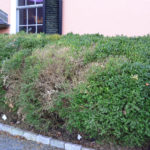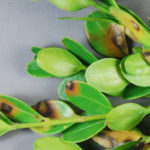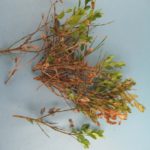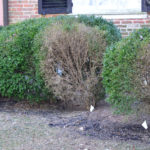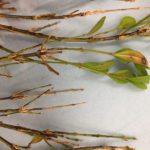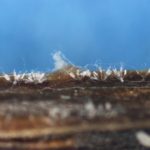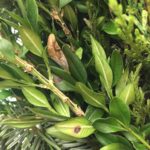Boxwoods losing leaves should not be ignored!! Check them carefully for tell-tale symptoms of boxwood blight, a serious fungal disease that causes rapid defoliation and dieback (Fig. 1). The fungus that causes boxwood blight can infect all above ground portions of the shrub. The first symptoms of the disease are dark leaf spots (Fig. 2 ) that progress to twig blight and rapid defoliation (Fig. 3) and eventual death of the plant if it goes undetected (Fig 4). The narrow black streaks (cankers) that develop on green stems (Fig. 5), are a unique symptom that differentiates boxwood blight from other boxwood diseases. During periods of high humidity, white, fuzzy masses that consist of numerous clumps of spores will emerge from these black stem cankers (Fig. 6) as well as on the underside of leaf spots. The spores can be observed on infected stems and leaves with a hand lens. These spores can be splash-dispersed through irrigation or rainfall, spreading the disease within a plant or to other nearby boxwood shrubs. Pachysandra is also susceptible to this disease and may become infected from rain/wind splashed spores.
- Fig 1 Boxwood blight defoliation and dieback (D. Clement; MD)
- Fig 2 Boxwood Blight Leaf Spots (N.Gregory; DE)
- Fig 3 Twig Blight/Defoliation (PPDL)
- Fig 4 Boxwood blight can kill plants (D. Clement; MD)
- Fig 5 Diagnostic black stem cankers (PPDL)
- Fig 6 Fungal spores develop on stem lesions when humid (PPDL)
This fungus is easily transported in the nursery industry and can be moved on symptomless infected plants, as well as on shoots of infected boxwood greenery tucked into evergreen Christmas wreaths (Fig. 7).
Since the first U.S. detection in 2011, boxwood blight has been reported in more than 20 states and three Canadian provinces. Boxwood blight has not yet been detected in Indiana landscapes or nurseries but in all reality –it is just a matter of time. It is imperative to be aware of the tell-tale symptoms of boxwood blight and to send suspect samples to the PPDL https://ag.purdue.edu/btny/ppdl when you see symptoms of this serious fungal disease in boxwoods in the landscape or nursery.
For more background and in-depth information on this disease please refer to our Purdue publication BP-203-W at https://www.extension.purdue.edu/extmedia/BP/BP-203-W.pdf
Additional information:
Virginia Boxwood Blight Task Force
ext.vt.edu/agriculture/commercial-horticulture/boxwood-blight.html
